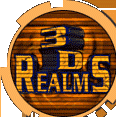






|
 |
Prey Weekly Development Update #16
Hey all,
Welcome to the 16th edition of the Prey Weekly Update. Today, we're covering many of those great Ask Prey questions that people send to us. A huge thanks to everyone for writing in with your questions. A few things to mention first:
- We received our shipment of the pewter figurines that will be included in the collector's edition of Prey. They're pretty kick-ass little figurines. Very nicely detailed. They look great sitting on my desk :)
- We're gearing up for E3. It's coming at a really weird time, though, as we're deep in crunch. On a positive note, there isn't a special E3 crunch going on like last year. This year, it's as easy as making a special copy of the game to take along for demoing.
- We're planning on releasing regular videos of Prey, as we count down to release. The videos will be anywhere from a minute to three minutes long, each showing off some cool sections of gameplay. The first one (which was released an hour ago) showcases a number of things, including wallwalking, portals and planetoid gravity. You definitely have to check it out.
- Hey, VoodooExtreme has had a Prey poll going on this whole week. Quick swing over there and vote!
Anyway, on to the questions:
Question:
Hi, may you can tell us what inside the collectors edition?
Thanks,
Markus Beier (Germany)
PS.: good luck - for a fast release!!!
Answer From Chris:
Hi Markus,
It just so happens we announced the contents of the collectors edition yesterday. The quick version is that the collectors edition is in a kick-ass metal box, comes on DVD, contains two pewter figurines (Tommy and the Hunter) and also had an "Art of Prey" book which contains some of the concept art from the game.
Check out http://legacy.3drealms.com/prey/preorder.html for more details and the longer version. :)
Question:
just wanted to ask the simple question:
Do dead bodies stay forever in the level or does they soon disappear? Is there a Cheat Code or can i modify a file to let them stay on ground forever?
Thank you very much!
Greetings from Germany!
Roman Masic
Answe From Chris:
This is something we experimented with for a while throughout Prey's development. We originally wanted the bodies to stay around forever, but realized that we would run into framerate issues (especially in combat heavy areas where the player is assaulted by waves of enemies).
In the early parts of the game, the bodies stay around forever. In later level (after the player has obtained the ability to SpiritWalk) the body will dissolve after the player retrieves the creature's lifeforce.
Amusing story about this -- a couple of years ago, a few of us were having an impromptu design meeting over dinner. Just discussing the game and some lingering issues that hadn't been resolved. One of them was the body dissolving. We knew we needed it, but we wanted a rational explanation for it.
We came up with all sorts of ideas, things like: alien tentacles that came up from the ground and sucked the body down, little creatures that would scurry out and consume the bodies, dark spirits that would come out and pull the body away (much like the unfortunate end of the bad guy Carl in the movie Ghost). But, all of those ideas had reasons why we couldn't use them (plus, I really wanted something that could be easily explained).
Someone suggested simply dissolving the body -- but only when the spirit was picked up. Simple, elegant, and easily done. Forgetting that we were in a crowded restaurant, I loudly exclaimed "Finally, a way to get rid of the bodies!" Which of course, caused the neighboring tables to give us some pretty freaky looks. :)
Such is the world of game development.
Question:
Dear Madam/Sir,
I have quick question regarding spirit-walking in Prey. I havent been able to find much information on it, but can spirit-walking be done anywhere in the game (like in Soul Reaver for example when you shift to the spectral realm) or can it only be done in specific places?
I hope you get time to answer my question, and I look forward to finally (!) getting to play this game. I remember reading the cover feature of it on an old Ultra Game Players mag in 1997!
And I'm still looking forward to it.
Regards,
Patrick.
Answer From Chris:
Hi Patrick,
SpiritWalking is one of the key features of the game -- so you can do it anywhere you want (well, after you've actually obtained the ability to SpiritWalk, of course).
We experimented with a lot of different ideas for the SpiritWalk mechanic, but finally ended at making it something the player can do all the time for as long as they want. There's no time limit to SpiritWalking, as there are some puzzles you have to solve while only in Spirit mode. It was confusing and frustrating for testers to be almost about to solve a puzzle when the time runs out and they are kicked back to their body.
Because of this, it sets up an interesting mechanic, where you can explore for quite a distance in Spirit mode I've seen some testers go into Spirit mode before every single room of the game. They drop their body in a safe location, and scout ahead -- trying to dispatch any enemies they encounter using the Cherokee Bow.
This doesn't mean that you can just run thorough the whole game in Spirit, though. The player is limited in other ways -- doors won't open for Spirit players (because the proximity detection for opening doors is based upon the proximity of a living entity).
Similarly, the Cherokee Bow is limited -- the Bow is only available if the player has Spirit power (obtained from the lifeforces of fallen enemies). Spirit power is depleted by using the Bow, or by taking damage from enemies.
Question:
Christopher Wilson writes:
Will Prey be able to make full use of the Creative SoundBlasterX-Fi? I mean, will it be able to utilise both the on-board RAM and EAX 5?
Answer From Chris:
Hi Christopher,
Yes, definitely. We support the X-Fi through OpenAL, so we have pretty cool EAX support in the game. Interestingly enough, Liam Byrne from Creative Labs is here at Human Head today, working with us on level-specific EAX implementation issues.
Question:
Hey,
Is there going to be a pre-release demo of Prey? If so, when will it be released?
Thanks,
Meharry
Answer From Chris:
Hi Meharry,
There will definitely be a demo for Prey. The timing of it has yet to be fully determined, as it may be shortly before the game is released or it might be shortly after. Regardless, it will definitely be around the time the game is released.
I've never understood the idea of releasing a demo so much later than the game -- by that I mean like two months later. Seems that you should get the demo out at least around the time that the game comes out. I can understand that a lot of people might be on the fence about a given game, and a kick-ass demo might be just the thing to convince them to buy that game.
That said, as a developer I can understand how difficult it is to try to create a demo at the same time that you are crunching to finish the game in the first place.
Question:
Hi again
Thanks for answering my questions.
I got a bit old PC, like over 3 years old: 2000+ cpu, 512 mb ram and a geforce ti 4200 128 mb ram graphic card. I've played DOOM 3 to the end with this PC, so I'm hoping that I can play Prey on it too.
I'll admit that I did experience some lag with DOOM 3, but I managed it anyways.
So my question is: Will Prey run on my pc ?
I'm thinking about buying more ram and a better graphic card. As a real 3D Realms fan, I don't care that much for the graphics, as long as the game has some cool gameplay. And it sure sounds like Prey has some fun gameplay!
Keep up the good work.
Kreg
uhm...yeah...hoping to see duke on E3 or a trailer of duke nukem forever on the Prey dvd.
Answer From Chris:
Hey Kreg,
Your PC should be able to handle the game, although parts of it are getting outdated. If Doom 3 was a bit laggy on your system, then Prey will be even more so. Our system requirements are higher than Doom 3's were.
What you identified there are too good places to target: More RAM is always a good thing, and getting a better video card will definitely help, too.
I certainly hope you like the gameplay in Prey. We've spent a lot of time developing it, and tuning it to be unique and fun. But, you'll have to be the final judge of that yourself!
DNF at E3: Not this year -- 3DR wants to concentrate on hyping Prey at this point.
Question:
Hi.
I'm webmaster from czech web site about pc games and I made game section Prey. I like your game very match, becouse has someting different, then other. I have a few questions to next weekly update.
Quaestions:
- You said. We can meet creatures, who won't be always enemys and helps us in game. How it will be make? How we can recognize on the first meet up who is enemy and who isnt(?
- Doom 3 was disapproved to small arenas in Multipaer Maps with small variability to play and have a fun. In Quake 4 it was be better, but not incomplete. You promise fights in arenas with changing gravitation and teleports. But, do you thing about Quake 3 Arena(Q3A)? It is steel one of the best multiplayer game, and fans stay playing Q3A although Qauke 4 more modern and have newes technical processing. Are you shure, you will not do same mistake?
- When do you publish official hardware requirements?
- How long will game takes in hours for a play?
- When do you make new screenshots for fans? Because there are only few places of whole game which we can in screens saw.
- And last qauestion. Are you preparing some mapeditor, or modding material for community?
Thaks you for answers.
Vokr
Answer From Chris:
Hi Vokr,
Whoa...quite a few questions here. Let's see if I can answer all these decently:
- Friendly characters in the game: We haven't really been talking about these friendly NPCs, primarily because we don't want to give away too much of the story. Suffice it to say that you will most definitely know which characters are friendly or not. Mainly because the friendly characters actually help you through the game. :)
- Prey's Multiplayer: I'm a huge fan of Q3A's MP. That was damn fun and highly polished and balanced. It still has some of my all-time favorite MP maps. I can understand why it is still the favorite of so many people out there.
But, we didn't try to model Prey's MP after Q3A, so you really can't compare them. They're both DM and Team DM based, but they definitely have a different feel to them while playing. We've taken all of the single-player core elements and carried them over to MP: SpiritWalk, WallWalk, Gravity Flipping, Portals, etc. All of these show up in DM, so it really gives the game a different feel and gives us a lot of opportunities for unique situations.
- Hardware requirements: We'll be putting this out very soon. Up until now we've essentially said that if you can run Doom 3 or Quake 4 decently, you should be able to run Prey. Our requirements are slightly higher than theirs. Of course, you could also get the 360 version (which is running very smoothly -- Venom is doing a kick-ass job).
- Gameplay hours? Depends upon the player. I think the average player will be in the 12-15 hour range. Some people who crank through the game will get through in less than that. Other people who really take their time will go over that.
- Screenshots: Man, we have something much cooler coming -- we're planning to release regular gameplay videos of Prey. So many things in the game just have to be seen in motion. A single screenshot just doesn't convey the experience of walking around on a mini-asteroid while sniping enemies.
- Map editor/mod stuff: Yes, absolutely. We plan to release all of our tools with the PC version of the game. I'm very much looking forward to seeing what people do with portals and gravity. There'll be some pretty wild mods out there!
Question:
Hey Chris,
First time writer, long time reader (sorry had to write that hah). Just a quick question.. when you guys first started Prey in late 2001 did you expect the end result (or near end result of course) to look like what Prey currently looks like now? Are there things that you guys have had to drop because current tech wouldn't allow?
If so any that you can mention?
Regards,
ADM
Answer From Chris:
Hey ADM,
Great question. The game looks better and plays better than we originally conceived. There was a long learning curve to the tech, and a lot of experimenting. In fact, I recently looked at a build of the game from late 2002. It's remarkable how much it has changed (maybe someday we'll release some screenshots from that old version for a laugh).
As far as things that were cut along the way -- many of the ideas cut were due to overreaching and inappropriate planning. We tried to do too much too soon right away (the original plan called for some 40 levels or so). We quickly realized that was way too much for the scope of this game.
One of the big things we dropped that I really wished could have been in the game is multiplayer co-op. The original design called for it -- and in fact, we have most of the puzzles and battles planned around what would happen with multiple players in them. But, there were some tech issues we ran into -- issues that would have required some significant changes to the code. At that point, we decided to shelve co-op in favor of putting our resources towards making stronger single-player and competitive multiplayer experiences.
Question:
Shival Sheran Sooknanan writes:
Really excited about the game, but is there going to be a "making of" video documentary as an unlocakbale or feature??
Answer From Chris:
Great question -- but, no, there will not be a making of video included in the game. There will be the "Art of Prey" book included in the collectors edition, though.
Question:
Alexander writes:
Since Prey has lot's of dialogs and oneliners, will there be an option to turn on english subtitles? To lighten the understanding of the speech itself for non-english speaking gamers.
Answer From Chris:
Yes, there definitely will be this ability. The game doesn't actually have foreign language voices, it's always English, but with the option for subtitles for each language. And, of course, English subtitles will be available.
On a similar note, one of the people who tested the game for us is deaf, so we received some invaluable feedback from him on the subtitles about ways to make them less confusing for someone who is deaf or who doesn't speak English.
Question:
Adam Konrad writes:
Can you tell us a little more about the multiplayer component? How many player models will the game contain? Is there an autodownload (from http or game server) and punkbuster support? What about server scripts and configuration? Do you plan to make some guide for these things?
Answer From Chris:
This answer is actually from Rich Whitehouse, network programmer on Prey:
We have a total of 13 multiplayer models to choose from. We have retained the autodownload functionality from Doom 3, which allows downloading via HTTP and directly from the game server. We've also worked with Even Balance in getting PunkBuster fully integrated, and it will be right there and ready out-of-the-box. As for scripts and configuration, we still have the custom map cycle script (among other things), so all of those surprisingly robust things that were in Doom 3 will be ready for tinkering. :) Generally, Doom 3 and Quake 4 server guides will answer all of your questions about setting up a Prey server, but we'll certainly be making sure we get info out there on anything that is Prey-specific.
Again, a huge thanks to everyone who wrote in with questions. I very much enjoy reading these and talking to people interested Prey. It so easy to get wrapped up in the day-to-day issues with game development, so it's nice to be reminded what this is all about: You, the game player.
Next week, we'll have something new and interesting, I'm sure. Scott Miller had a few ideas for a weekly update, so we'll see if next week is a good time to unveil those.
Make sure you watch GameSpot tonight, too! :)
Until then, stay out of trouble....
Chris Rhinehart - Prey Project Lead
Human Head Studios

Click the screenshot to watch Prey in action on the videos page!
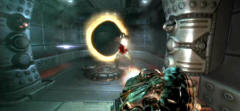

Additionally, if you are a gaming news website, and wish to be updated directly with notification of these updates, please email us with a link to your website and a request to be added, and we'll email you with the next update.
Posted by Joe Siegler at 5:17 PM
| Discuss this story on our forums
|
 |
 |
 |
 |
 |
Duke Nukem Forever Someday
 Today brings some rather funny news; we were mentioned in today's FoxTrot comic strip. In this entry, Bill mentions Duke Nukem Forever as a reason for one of the characters (Jason) to buy an iFruit (the FoxTrot nickname for one of the new Macs that runs Windows). As usual, the toon is darn funny. Check it out by clicking on the thumbnail. Today brings some rather funny news; we were mentioned in today's FoxTrot comic strip. In this entry, Bill mentions Duke Nukem Forever as a reason for one of the characters (Jason) to buy an iFruit (the FoxTrot nickname for one of the new Macs that runs Windows). As usual, the toon is darn funny. Check it out by clicking on the thumbnail.
Thanks again to Bill for the mention! You can read more info about FoxTrot either at it's official site here, or over at Wikipedia.
UPDATE Wed 4/26: A couple of us wrote to Bill saying we enjoyed the strip, and Bill Amend wrote back to Charlie Wiederhold, and said this:
"Thanks. Fun to hear from you.
Of course, given how chronically late I am with my strips, I'm probably the last guy who should be poking fun at slow-to-ship games. Hope it's going okay.
Bill Amend"
Posted by Joe Siegler at 10:33 AM
| Discuss this story on our forums
|
 |
 |
 |
 |
 |
Prey "Super Trailer" High Quality Video File Released
Following up on Friday evening's news, we're here to bring you a high quality downloadable video file of the new "Prey Super Trailer" by Jeron Moore. This is a 40 Meg Quicktime 7 (H.264) high quality file that Jeron sent us over the weekend.
Here's a list of places where you can get the file from, which we'll be updating during the day as more links come in. If you're a gaming news site and have a link for folks to download the file, please email us and we'll get you added to the list.
In addition, make sure to check out IGN.com, where they also have a story by Jeron Moore on the making of the video, which you're sure to find interesting as well.
UPDATE @ 8:45PM: Now that the file is available on Google Video, it can be streamed via a web browser. You can click play on the Google Video player below to watch the video direct on this website, and then you can download the file above for a greater quality video to keep on your computer.
Posted by Joe Siegler at 8:47 PM
| Discuss this story on our forums
|
 |
 |
 |
 |
 |
The Apogee Legacy #16 - Jason Blochowiak
Today our "Apogee Legacy" Interview series continues on with an interview with Jason Blochowiak. Jason's company "Argo Games" was responsible for the 1996 title, "Xenophage" with us. In addition to Xenophage with us, Jason was also involved back with id Software in the day, and was a co-owner of id for awhile in 1991. Jason did sound code for id games back in the Keen/Wolf era, wrote code for Keen Dreams, etc. So his name should be familiar to fans of our company's Legacy titles.
Xenophage was our lone attempt to get into the fighting game market. Xenophage did bring a lot of firsts into this genre of game. We did try a second fighting game with someone else, but it was never released, so Xeno remains our lone entrant into this style of game. In fact, this interview is coming out at a very timely manner. On April 26, 1996, Xenophage v1.0 shareware was originally released. So this is the 10 year anniversary for Xenophage, and because of that, we also want to announce that we're releasing the full version of Xenophage as freeware to go along with this interview and the anniversary. Read through the interview to get the download link. The Xenophage freeware release also has another tie to our current product. The "Art Director" on Prey is Rowan Atalla, who was Jason's parter in Argo games. Rowan also did art on Xenophage; things have a tendency of coming full circle, don't they? :)
We thought last week's entry in the series by Peder Jungck was the longest in terms of words, but Jason's now holds that record. Jason talks at length about many of the sujects in the interview, including what he's done post Apogee. This is a very long, and very good interview, so make sure to check it out.
The Apogee Legacy
Past Pioneers of the Shareware Revolution
Issue #16 - Jason Blochowiak
1) How did you first come in contact with Apogee?
Well, I was around when the Id guys first got going - Jay Wilbur, John Carmack, and I were all living in the same house when Id started. After I left Softdisk, I worked with Id briefly (during the Keen 4-6 & Wolf 3D era) when they were working with Apogee. So that's how I got to know Scott, George, and other Apogee folks. Later on, when I decided to make a fighting game (ultimately titled Xenophage), I contacted them, and they showed interest in helping develop it, and publishing it.
2) Was there a reason you decided to work with Apogee, say versus going on your own or working with another company?
The fact that we all knew each other certainly helped, and Apogee's friendly style of doing business was also a plus. They were also successful enough to help out significantly with funding, which was important for our small studio.
By the way, Xeno was our first experience with "outsourcing" art - it's interesting to see more companies doing that sort of thing these days, and I see them experiencing the same set of issues that we ran into. We ultimately pulled all art production in-house to finish the game, but we wouldn't have been able to get the initial assets in place without the outsourcing effort, and we wouldn't have been able to get those without Apogee's help, both logistically and financially.
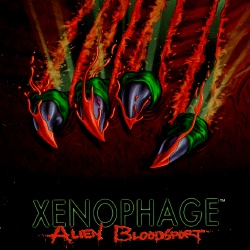
|
|
Box cover art for Xenophage
|
3) Looking back, was there anything Apogee could have done better, regarding the marketing and distribution of your game?
No, not that I can think of. Apogee's prominence in the shareware industry pretty much guaranteed broad exposure for any titles they released. Keep in mind that this was before the Internet had "gone wide" - it was pretty much only for researchers, academics, and students. So, shareware lived on Bulletin Board Systems (dedicated machines with banks of modems that you'd call into), and shareware catalogs. Because everyone knew Apogee as a premier shareware brand, any shareware releases were quickly disseminated from the original release points (equivalent to current "file mirroring"), and got large amounts of page space in the catalogs.
4) Do you think your game was made better or worse by working with Apogee?
Definitely better. In retrospect, the biggest thing my studio (Argo Games) was lacking in was game design experience, and the guys at Apogee definitely pushed us in the right direction - if anything, we probably would've been better off listening more.
I go into a bit more detail later about this, but I've been hopping between game genres my entire career. This has a number of advantages, but it does sometimes mean that my understanding of a particular genre will be deeper at the end of making a game, rather than at the beginning, when the game is in the planning phase.
5) Apogee had a policy of letting the designer or studio retain full intellectual property rights to their game. Nowadays, it's rare to find a publisher who allows this, especially if the publisher is providing the funding. Do you believe that it's best for the creator to retain IP rights? Why or why not?
As an independent developer, I'd say that it's definitely beneficial for the studio to retain the IP. Of course, the publishers generally have a different take, for fairly obvious reasons.
It seems that the conventional wisdom about this is that the publishers are taking the financial risk, so they should own any resulting IP. This completely ignores the much larger personal risks that people at smaller studios take. The days where everyone at a studio is a scruffy 20 year old, and the difference between the studio doing well or doing poorly means the difference between good beer or cheap beer - that's gone (well, at least for the majority of large-scale professional developers – see #13). Most of us now have mortgages and spouses, and quite a few of us have kids. Not to mention that doing games means working twice as hard for half the pay of other (albeit, far less interesting) jobs.
Of course, the exception to this is where the publisher brings the IP to the table in the first place - either something they developed internally (like, say, extending a franchise into a different genre), or a license that they're shopping to developers.
5a) And if applicable, have you benefited from retaining ownership of your own IP?
It certainly leaves more options open. In the specific case of Xenophage, I don't think it will make a practical difference (see next question), but there are other back-catalog titles of mine where it might - and that's the important thing, that I have the choice, without having to negotiate to release rights with anyone.

|
|
Jason and his wife on vacation in Istanbul
|
5b) Do you think there'll ever be a sequel to your game(s)?
We're probably not going to be seeing Xenophage II. I mean, it brought some stuff to PC fighting games that hadn't been seen there before - like the zooming playfield that let us have large, detailed character sprites. However, the game really missed striking the right nerve in the gaming public. There were a number of issues with the game, but I think the statement (from some random person on a message board somewhere) that sums up the public's reaction was the the fighters were "too big, and too weird."
6) Is there any story/incident that stands out as interesting during your time associated with Apogee?
Sheesh, it's been almost ten years since Xeno got released, so I'm sure there's plenty of amusing stuff that I've completely forgotten.
7) Apogee was an early pioneer in terms of teaming up with external designers and studios, and continues to do so even to this day (currently working with Human Head Studios on Prey). Why is it that so few other studios do this (mentor and fund outside projects with lesser known teams)?
Clearly the stakes are getting much bigger for front-line titles. The more money is involved, the more conservative people get. As with everything, there are a set of tradeoffs - people at smaller studios tend to be more devoted to getting it right, compared with "gameplay programmer #47" at the bigger places.
8) What the biggest difference in the industry nowadays versus when you worked with Apogee?
The biggest thing would have to be the money. Back in the day, 3-5 people could put out a front-line game in well under a year, with budgets that were in the low hundreds of thousands, if even that much. The last two projects I worked on before I left Midway had budgets that were, well, I'm not allowed to tell you the exact numbers, but both had 8 digits to the left of the decimal point.
Things are also more, well, deliberate. With bigger projects and more people, much more planning and logistics are required now. Everything was a lot more cavalier back then - it's been interesting watching the game industry go through the process of maturing.
9) What have you been doing since your time with Apogee?
(Pardon the relative long-windedness here - more than two-thirds of my gaming career has been after Xenophage was published!)
Awhile after Xeno was released, I decided to try a somewhat different career path - I hadn't ever worked for a larger company, so I joined Midway at their Chicago studio.
I've been pretty happy that I've been able to work on so many different game genres - puzzle (Rescue Rover 2), platform (Keen), fps (Wolf3D), board (Hexxagon), trivia (Trivia Shell), fighting (Xenophage). I hadn't done any arcade games, though. So, after helping out on the tail-end of an arcade gun game (Carnevil), I led the programming effort on an arcade snowmobile racing game (Arctic Thunder). Arctic was a fun game with broad appeal, and it sold well, but the arcade industry in general was on its last legs, so Midway exited the arcade business, and focused entirely on home consoles.
After Arctic, our team pitched a number of concepts to management, and the one that stuck was what turned into "PsiOps - The Mindgate Conspiracy." It was definitely an interesting experience - although I had helped out the people porting Arctic to the PS2 and Xbox, I didn't really have any significant console programming experience. So, starting with a blank page and building a new cross-platform game/graphics engine and toolset for a genre I hadn't done before (3rd person action/adventure), on platforms I hadn't worked on before (PS2, Xbox, and Gamecube), recruiting, managing & directing a programming team larger than ever before (up to 20 programmers, at one point) was, well, to call it challenging would be an understatement. It was an intense few years, but I'm really proud of the game on a number of fronts.

|
|
Xenophage Screenshot
|
On the anal-retentive side, it's great that the game was so clean (actual professional tester quote - "It's really frustrating when your job is to break the game, but you can't.") that our QA costs were below 50% of the company average, and that we got quick approval from the console manufacturers.
On the "I made that" side, PsiOps garnered the highest aggregate review scores of any title developed internally at Midway, and the second highest of any title ever published by Midway. This at a time when management was really wanting to improve expectations about the quality of the console titles coming from the company.
On the "holy crap, we pulled it off" side, the programming staff started with one programmer (me), added a mix of a few industry vets, some folks with some game experience (but not necessarily a whole lot), and some complete gaming noobs who showed general promise, and came together as a team to make a game we are all proud of.
There is one Chicago restaurant's pizza, though, that none of us ever want to see again. Ever. Really. Not because it was bad, mind you, any food that you eat that much of during months of crunch – you’re just going to get sick of it.
Anyways, after PsiOps, I provided some initial technical direction on a new project ("John Woo's Stranglehold") for next-next-gen consoles, which looks to be on track to really capture the full essence of the cinematic experience of his action films, to a depth that gamers haven't seen before. It's a great team, doing some great stuff, but I'd been at Midway for 7 years, and I guess the 7-year itch set in, so I decided to move on.
So, p1mpage for my new venture: Monster Entertainment! My partners (who are finishing up their current gigs) and I are striking out on our own and starting a new studio. There are a number of factors that shape the culture of a work environment, and we have some very specific ideas about how to (and how not to!) build a studio that's functional, profitable, and a personally rewarding place to work for everyone involved.
Additionally, although the PsiOps engine was a decent enough piece of engineering, it was rooted in my understanding of the world (and software engineering) as of 4 years ago, and I've learned so much since then - it's great to be able to start over fresh, and build new tech that's clean, flexible, and poised to take advantage of the latest crop of PC and console hardware.
As a side benefit of building fresh tech, it's been great fun to brush up my graphics programming skills - even though, at the end of the day, writing HLSL code isn't all that incredibly different than writing VU1 code, and dealing with the PS2 DMA controller and VU1's limited memory looks a lot like dealing with the Cell SPE's "Local Storage." Despite the similarities, the increase in raw power that's available with the current crop of GPUs does make for some interesting possibilities - in particular, I think going for "photo-real" will become increasingly passe, and going beyond it will be a part of the visual branding process for studios.
10) If you're no longer making games, have you thought about returning to this industry? If not, why not?
Well, seeing as I am still making games, I'll reverse the question to "why are you still making games?" The answer is that it's still interesting to me. As I mentioned above, I'm very happy I've been able to avoid doing the same game over and over again. I've had the opportunity to work with a wide variety of hardware, software, and wetware. There's enough continuity of what making games is about, so I'm not totally bewildered as new cycles of hardware come along, but there are enough differences to keep things interesting.
I actually think there are a number of strong similarities between making games, and cooking (which is pretty much my only hobby). Both involve basic technical skills, without which you can't really do anything. They involve the psychology of the consumer. They require foundations in things people are comfortable with, but to be successful you need to introduce fresh elements, and keep evolving.
In the professional sense, for both heading a team or studio's programming effort, and heading a working kitchen, the skills you need to develop reach beyond craftwork. There's a certain magic required to transform a collection of different people, with different technical skills, different educational backgrounds, different levels of social skills, etc., into a functioning team that can deliver under intense pressure. Learning that magic is tricky, but interesting.
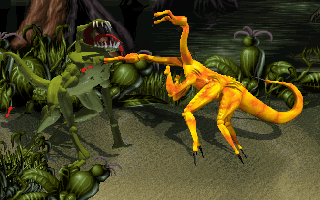
|
|
Xenophage Screenshot
|
11) Looking back, are there any missed opportunities that you wish you'd have jumped on?
Well, buying more Midway stock when it was at $4.43 and selling it when it was at $23.73 would've been good, but aside from that, not really - I've been really fortunate to have all the opportunities I've had.
12) Other than your game(s), what's your favorite game released or produced by Apogee (or 3D Realms)?
I'd have to say Duke 3D. I hear there's a sequel being worked on, but it hasn’t come out yet.
12a) And what's your favorite 2-4 games released by anyone else?
Half-life 2 was pretty excellent. My first experiences with Steam weren't.
I've had a running love/hate relationship with the Civ series for quite awhile now. More love than hate, though.
Baldur's Gate II is definitely on the list.
Age of Empires III ate at least a couple weeks of my life recently.
13) Is there anything else you'd like to add about your time here or to fans of your title(s)?
Well, I'll take this occasion to ramble a little (more). The Chinese curse of "may you live in interesting times" definitely seems to apply to the game industry.
While AAA game budgets are skyrocketing to levels that frighten anyone with a calculator and a brain, it's also interesting that the actual barrier to entry for making simple games has gone to pretty close to nothing beyond having a PC of moderately recent vintage, and a willingness to learn & put some hard work in.
When I took a gander at the source code archive for Xeno, there were something like 20 variants of a routine to copy graphics rectangles around in different ways, all hand coded in assembly for speed. Now, even the cheapest graphics hardware handles all that, and tons more as well.
You can get an industrial grade C++ compiler for free, including a fairly comprehensive Integrated Development Environment, in the form of the Visual C++ 2005 Express Edition.
The DirectX SDK, by itself, includes a ton of code to springboard from (some of it good, some of it crap), and a bunch of free utilities that easily accomplish what experienced folks were tearing their hair out about not all that long ago. HLSL/Cg is much easier for most people to understand than the previous iterations of vertex and pixel shaders.
There are free image editors (and a bunch of free textures out there). Free modeling and rendering programs (and a bunch of free models). Free scripting languages (why anybody "invents" any more game scripting languages is really beyond my comprehension at this point). Free language parsers (Spirit is interesting to play with). XML can handle a bunch of things handily, and there are free XML parsers, processors, transformers, etc. Free audio compression/decompression - with Ogg Vorbis and OpenAL, I added streaming music/sfx to my new engine in less than a day. Now, granted, I’ve been doing this awhile, but that timeframe had more to do with ease of use than it had to do with experience.
So, with all this available, a determined programmer can put a game together without too much difficulty, and the only difference (albeit an important one) between what a solo amateur can do versus a seasoned team is cranking out professional content with the appropriate level of polish.
What does all this mean? Well, lower barriers to entry means more crap, but it also means that someone out there somewhere can make a little game, get it out there, and actually make money from it – just like back in the day.
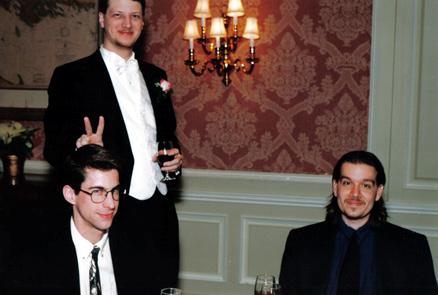
From Jason Blochowiak's Wedding:
Dave Mueller, Jason (standing), & Chris Rhinehart.

From Jason Blochowiak's Wedding:
Jason & Kristin (standing), plus Erika & Rowan Atalla.
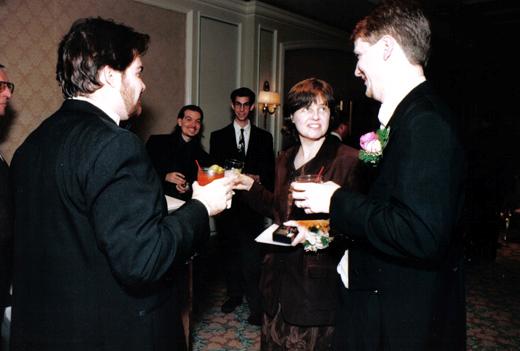
From Jason Blochowiak's Wedding:
Rowan, Chris, Dave, Pat, & Jason
A few words about the people in the pictures from Jason:
- Chris (Rhinehart) - Prey's project lead for Human Head. Fellow Lead Dog programmer with me on the freeware 33-hour insanity project "Duelling Minivans" and the followup "Super Duelling Minivans."
- Dave (Mueller) - At Midway, currently on the MK team, I believe. Worked at Argo after Xeno, before Midway. Currently has my Arctic Thunder arcade machine in his apartment (because none of the doorways in my house were big enough).
- Erika (Ersland) - Kristin's older sister.
- Jason - um, me.
- Kristin - my wife.
- Pat - my mom.
- Rowan (Atalla) - my best man - I believe his current credit is for art lead on Prey. Xeno was his first intro to non-traditional media. Clearly his mastery of the subject has improved with exposure - just take a look at Prey.
Thanks for Jason for writing such a good, long interview. Thanks also to him for allowing Xenophage to be released as freeware. Check out these various links below.
Make sure and tune in again next Monday morning, when we bring you the next in our Legacy Interview series.
Posted by Joe Siegler at 12:00 PM
| Discuss this story on our forums
|
 |
 |
 |
 |
 |
Prey "Super Trailer" Released
You've asked for more Prey footage, and we're here to deliver. Available right now on IGN.com is an exclusive brand spanking new trailer for Prey. Weighing in at about 3 minutes 45 seconds, this new trailer contains a lot of footage that you haven't seen before. We don't want to spoil it all here in this announcement for you, so we'll just let you check it out.
The video was produced and directed by Jeron Moore for 3D Realms. In addition to the video, there is an article by Jeron entitled, "The Making of the Prey Super Trailer" in which Jeron goes into detail on the creation of the video, and shows some of what goes into making one of these things. The full article is over at IGN, but here's one small clip from it you might find amusing:
"The live action footage was shot at the end of May 2005. My location of choice? Vasquez Rocks State Park - about 45 minutes north of downtown Los Angeles. Star Trek fans, this is the same exact location Captain James T. Kirk did battle with the Gorn captain (ST:TOS - Arena, - 1966). I thought it appropriate we bring Tommy to this location - he and Kirk would have either hit it off really well, or ended up kicking each other’s asses."
This new stuff is hot, so make sure and head on over to IGN and check it out the trailer, as well as the making of article right away. We think you'll really enjoy this.
Posted by Joe Siegler at 8:00 PM
| Discuss this story on our forums
|
 |
 |
 |
 |
 |
Prey Weekly Development Update #15
Welcome to the fifteenth Weekly Prey Update. I apologize for being so late today, but I think this picture pretty much sums up this week:
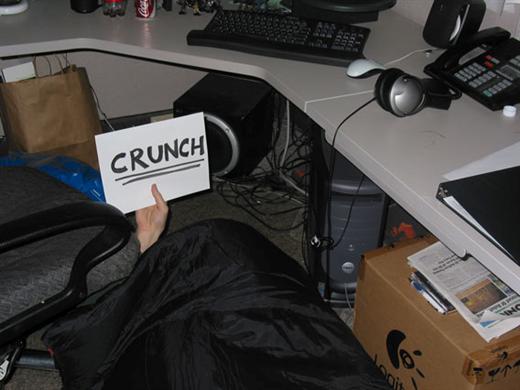 Script Manager Mike Flynn annoyed at having his brief sleep disturbed ....
Script Manager Mike Flynn annoyed at having his brief sleep disturbed ....
Make sure you read to the bottom of this update for some cool Prey news later tonight!
We have a guest update from Nick Murray of Artistry Entertainment. The band MXPX specially recorded a song for inclusion in Prey. The song is called "The Setting Sun", and here's a brief update from Nick about the recording session earlier this week:
Recording `The Setting Sun' with MxPx.
By Nick Murray, Producer "Bite Me! Music inspired by Prey," DirectSong.com
I, like many people have been a big fan of the popular punk rock band MxPx for years. Quite familiar with their song "Move to Bremerton" I was excited to spend a day with the band in their hometown - Bremerton, Washington. But first I had to find out where in the world Bremerton was.
On a beautiful day in Seattle, I made my way to the ferry pier and drove my car onto one of Seattle's famous ferries. During the 60 minute ferry ride across the Puget Sound, I saw 2 sea lions and 1 bald eagle. This was going to be a good day!
When I arrived in Bremerton I noticed some US Navy ships. In 1891 a German immigrant named William Bremer sold some of his land to the US Navy and founded Bremerton. The US Navy still has a base there.
I followed my map to MxPx's studio and they were just beginning to record the drum track for their new song "The Setting Sun." When recording rock songs, bands will always record one part at a time (drums, vocals, guitars, etc.) in order to get the highest quality sound. With Yuri playing the drums, Mike recording the session, and Tom practicing his guitar parts, I knew these guys were professionals.
After only 3 or 4 takes, Yuri nailed the drums, yet stayed the rest of the day to support the band and help out with recording the other band members.
Besides listening to my own free punk rock show all day, I was impressed with their speed that they were able to fly through the recording session. They moved from drums to rhythm guitars, to bass guitar, to vocals, and then to lead guitar and they did it all like clockwork, without any cutting remarks, squabbles, or wasted time.
One thing was evident, amidst their professionalism and ability to write, play, and record a song, they were obviously friends as well. They are a true rock band from their roots in Bremerton, Washington to their sell out crowds in Chile, Japan, Europe, and across the globe.
Be sure to check out their new original song "The Setting Sun" only in `Prey' and on `Prey''s compilation album "Bite Me! Music inspired by Prey" available for download only at http://www.directsong.com.
Find out more about MxPx including their latest album and tour dates at http://www.mxpx.com
MxPx is:
Mike Herrera - Vocals, Bass Guitar
Tom Wisniewski - Guitar
Yuri Ruley - Drums
And of course, the ever-popular changelog:
- SpiritArrows can go through forcefields, spiritbridges, chaff
- Bullets now hit spirit secrets instead of going through
- made shuttle headlight smaller/faster
- deny invalid punkbuster joins with dialog box
- new shuttle crosshairs
- added auto weapon switch to mp menu
- made crosshairs not highlight consoles.
- Made the blood splats on the rifle and auto-cannon bigger.
- fixed health and spirit pulses happening when they shouldn't on client
- added more randomness to the spawn logic, since apparently spawning from the most distant point is being counter-productive and making people think they're spawning near their killer just because it's repeatedly picking the same point. spawning from a random point (still tries to pick > 128 distance though) will probably feel better.
- fixed lowhealth sound not playing properly on the client in mp
- Fixed gasbag damage material problem.
- Fixed wallwalk traces to prevent players from falling off in some situations.
- Added code to crush movables blocking harvester passageways.
- long wait idles for rifle and crawler going in
- Finally received the last music update from Jeremy
- New Tommy dialog added in all maps
- salvage: added hound doors script support for ted
- changed fade time for music coming back from deathwalk
- salvage: added dialog for abducted in wallwalk puzzle room
- fixed talon model so he actually looks like a hawk
- talon attack code is fixed, and talon properly banks as he flies around
- slowdown when close to portals fixed
- lots and lots and lots of bugs fixed
I apologize for not getting to those Ask Prey Questions -- they will definitely be posted next week. Things have been completely insane around here. The good kind of insane.
Also, huge news! Later tonight, a new Prey Trailer will be released through IGN. Watch for it to be released around 8 PM CST. More info will be posted soon on the 3D Realms site. You won't want to miss that.
Chris Rhinehart - Prey Project Lead
Human Head Studios

Click the screenshot to watch Prey in action on the videos page!


Additionally, if you are a gaming news website, and wish to be updated directly with notification of these updates, please email us with a link to your website and a request to be added, and we'll email you with the next update.
Posted by Joe Siegler at 5:31 PM
| Discuss this story on our forums
|
 |
 |
 |
 |
 |
Prey Pre-Order Info & Pewter Figures
Pre-order plans for Prey will be announced soon. There will be a collector's edition (both PC and 360) as well as the standard versions. Until then, here's a sneak peek at three pewter figures we will be including with the game (details coming soon).
The figures were done by "Reaper Miniatures", and what you see here are the early prototype Greens that are used to make the actual pewter figures.
We have three video files for you; all are Quicktime video, and on all of them you can grab the picture and rotate the figures' view 360 degrees. If you wish to download the files, you can do so with the following links. Both require the use of the Quicktime video player from Apple.
Download Links: [ Tommy | Hunter | Mutate ]
Keep your eyes peeled here for pre-order information soon. We will provide information on how and where to pre-order the game, plus information on how to get the various figures.
Here are some inlined versions of the videos above. These require you have the Quicktime plugin active in your browser to view them. You can use the shift and ctrl keys to zoom in and out, and use your mouse to click and drag the video to spin the figures around.
Posted by Joe Siegler at 1:41 PM
| Discuss this story on our forums
|
 |
 |
 |
 |
 |
The Apogee Legacy #15 - Peder Jungck
 Today our "Apogee Legacy" Interview series continues on with an interview with Peder Jungck (pronounced 'junk'). Peder was responsible for the 1992 title, "Secret Agent" with us. Today our "Apogee Legacy" Interview series continues on with an interview with Peder Jungck (pronounced 'junk'). Peder was responsible for the 1992 title, "Secret Agent" with us.
Secret Agent was Peder's only title with us. It was a cool little game that yours truly bought before he started working here all those years ago. :) Anyway, it's a game where you play Secret Agent 006 1/2 on a mission into the secret island fortress of the DVS. Secret Agent, along with Crystal Caves are believed to be the #1 & #2 record holders for time elapsed between original release and a maintenance patch release. For Secret Agent it was just about 14 years between it coming out, and us releasing a patch for it in October of 2005.
Peder is no longer making games, and was a little harder to track down than most of the folks for this series, but we're glad we did. We haven't spoken with Peder in several years, and as you will find out by reading his interview below, he was more than happy to contribute. In fact, Peder wrote probably the longest entry in terms of words for the series. It's a great read, covering all kinds of stuff.
The Apogee Legacy
Past Pioneers of the Shareware Revolution
Issue #15 - Peder Jungck
1) How did you first come in contact with Apogee?
In the late 80's I wrote a graphics package for the Zenith-100 (pre-PC & EGA days) that was used for many of my early games on that platform. When the EGA video adapters started driving decent graphics in the PC I ported my libraries and developed a commercial product called the ProGraphx Toolbox. I advertised these tools in Programmer's Journal and wrote several articles on graphics programming. George Broussard was running MicroFX and had purchased the ProGraphx Toolbox and contacted me about doing some enhacements to the library. As it turned out, I had just recently moved from Chicago to Arlington Texas, not too far from George in Garland. We got together one day at a Chili's to discuss the requirements and it grew from there.
2) Was there a reason you decided to work with Apogee, say versus going on your own or working with another company?
I had developed games ever since I was 10 on platforms like the Commodore Pet & VIC-20, Apple II & Mac and Zenith-100. I had my own companies, published through bigger companies and at times worked with small incredibly talented teams. Having experienced some of each I have come to the conclusion that the best things happen when you find a group of incredibly talented people driven with a vision. George and Apogee were just such a group. When you meet great people with vision, your decision is not about some calculated move of which company but rather one of excitement and fulfillment of goals. So, if I were to place one reason of why Apogee, it was all about the team.
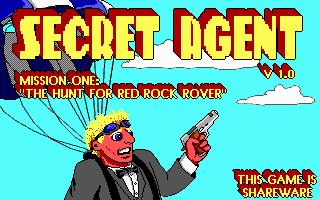
|
|
Title screen for Secret Agent
|
3) Looking back, was there anything Apogee could have done better, regarding the marketing and distribution of your game?
I had a great experience with Apogee and thier ability to market. In the days of bulletin boards and emergence of Shareware in packaging at the computer stores I felt like my game was in front its target audience. Within the first few months the sales started ramping up and response was positive. Secret Agent did very well in its first year and if there were anything they could have done better, it would have been to kick my tail to have gotten it out a lot sooner as it was on the tail end of the side scroller generation. In actuality, without the marketing genius of Apogee to develop the 3 episode shareware approach where episode 1 was free and 2 & 3 cost money shareware marketing was a bust. Additionally, the development of cheat codes in every game with access only through purchase made it as captivating as an infomercial today. Apogee had the best marketing in the shareware gaming space hands down.
4) Do you think your game was made better or worse by working with Apogee?
Definitely a better product. Apogee drove the quality of the game play, pushed for high quality graphics and did extensive quality assurance testing to ensure compatibility and in those days completability of the game. We found issues where certain EGA cards didn't pan thier graphics smoothly and had to make modifications to support each. Apogee brought in artists to do opening cover art and upgraded the icon and pixel graphics for smooth character movements. Apogee invested in each developer and each product extensively in a tight relationship more so than the publishers of the day.
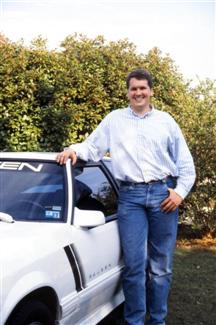
|
|
Peder in 1992
|
5) Apogee had a policy of letting the designer or studio retain full intellectual property rights to their game. Nowadays, it's rare to find a publisher who allows this, especially if the publisher is providing the funding. Do you believe that it's best for the creator to retain IP rights? Why or why not?
I do believe that it is important for game developers to retain rights to thier work. In many ways this is an art and one does not want to constrain an artist. That said I think that the IP rights issue in the early days was a bit different than it is today. For one, the product was often created by an individual or a small team. Today, it often can take dozens or even more than a 100 for big title. Second, gaming has become big business and as such intellectual property protection, lawsuits, cross-promotion deals and branding is expensive. I think that an individual won't be able to fully maximize the potential of thier intellectual property value today as they did then. I believe that the choices by Apogee in the early days of PC gaming was the right choice and part of thier success. I am not sure that I believe that this is the best choice today for either the publishers or designers.
5a) And if applicable, have you benefited from retaining ownership of your own IP?
I have benefited in two ways. First, it brings a peace of mind. I have often thought of playing with the software to experiment with gaming on other platforms. I know this code (although not well anymore) so it always seems easier to take an existing code base to try something rather than start from scratch and know that you are potentially violating an agreement. The second way is that I have watched the resurgence of casual gaming on devices like PDA's and cell phones. I truly believe there is an opportunity for the revitalization of the Apogee phenominon that occurred pre-3D on portable devices. Having a say in this option is valuable.
5b) Do you think there'll ever be a sequel to your game(s)?
Sure, if not we close the door and every great trilogy needs to leave the door open. On the PC, I would doubt it unless it was written by one of my sons and fortunately that's not too far out of the question. If there is, I would see it on a cell phone. Besides that is more Secret Agent 006 1/2's size. :>
6) Is there any story/incident that stands out as interesting during your time associated with Apogee?
While I recall many long nights on the phone and transferring files and bug lists it was the social times that are most memorable. Being a car guy, I must say that high end cars have always been a big motivation in life. I recall meeting with George driving my 4-cylinder mustang and he had an old camaro. One day as things were starting to pick up for Apogee and George tempting me with the fruits I would see when my game shipped, he showed up with a bright red Acura NSX. Mind you in the early 90's in the wake of depressing cars from the big 3, this was an almost iconic vehicle. There is no low end version of an NSX, it was pure race technology design from the ground up. Getting to drive that car provided a memory I will never forget and it drove me to finish my game fast. Net result, spend most of my first few months sales on my Saleen Mustang and a 1966 Mustang painted to match. Every time I see an NSX I think of Apogee even today.
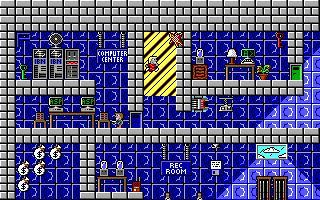
|
|
Secret Agent Screenshot
|
7) Apogee was an early pioneer in terms of teaming up with external designers and studios, and continues to do so even to this day (currently working with Human Head Studios on Prey). Why is it that so few other studios do this (mentor and fund outside projects with lesser known teams)?
I think that to be successful at this the business leaders need to be gamers, passionate, involved and savvy business people all in one. This is a rare combination to find in a small group of individuals. It also needs to be part of the culture from day one. Apogee was a special place that resulted in special products.
8) What the biggest difference in the industry nowadays versus when you worked with Apogee?
Shortly after my Secret Agent days with Apogee, I went from building games on the side to doing gaming for full-time business. TerraGlyph Interactive, a CD-ROM edutainment company I helped start, was one of the first of the big business venture capital based mega game companies. In a matter of a few years in the 90's, the scale of titles went from a few developers over the course of a year to a title I directed and produced, Beowulf, had over 200 people-years of effort to product and millions of dollars. I have heard that the gaming industry is driving more revenue than movies in some categories and the technology required to develop has become increasingly complex. Just like the Internet has gone from a government and university experiment to the change of a culture, gaming has gone from its small text based adventures to massively multiplayer games that are leading to online dating and marriage. This is a night and day difference, however, deep inside these organizations, there is still the passionate gamers spending late hours coding and drinking Mountain Dew. That is the industry I miss and still look for because it contains the heart of what will always keep gaming on the top of the entertainment charts.
9) What have you been doing since your time with Apogee?
Building and playing games was a passion as a kid and a sideline through college and afterwards bringing in lots of enjoyment and money for college bills and cars. After Apogee I published a book on gaming, Graphics Programming and Animation, that was one of the first for PC gaming that was very successful for me. I then went into gaming full-time for the first time ever with TerraGlyph that ran for 3 years before the big game systems and Internet revolution changed gaming from CD-ROM onto its next phase. TerraGlyph got me hooked on big Venture backed startups in my home turf of networking and high end computing. I have continued to do startups since 1997 running a IT Consulting and Systems Integration house in Chicago, taking the role of CTO at yesmail.com which we took public in 1999 and then starting CloudShield Technologies in 2000 which develops supercomputers for the network that are sold to the service providers and government. I spend most of my time solving multigigabit problems for processing applications such as VoIP and Security on the Internet.
10) If you're no longer making games, have you thought about returning to this industry? If not, why not?
Sure. Once a gamer, always a gamer and every time something new comes up you can't help but think of the good times. Ideas continuously pop up that makes me think about how to find the time to do just one more foray into gaming. I gotta tell you, mobile phone look just like an old 286 with EGA to me perfect for those old side scrollers. Maybe I could use this forum to announce Secret Agent for Windows Mobile?
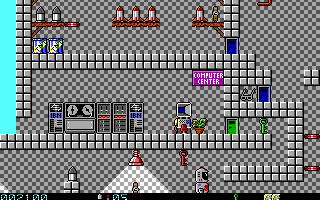
|
|
Secret Agent Screenshot
|
11) Looking back, are there any missed opportunities that you wish you'd have jumped on?
Sure. I watched the 3D events unfold before my eyes and even had an engine built in 93 that if I had jumped on could have done well. Do I have regrets, no way. The real-time programming and detailed hardware knowledge I learned in bit blasting the EGA/VGA gave me an understanding of computing that has formed a basis of what I do today. In many ways we all make decisions that we can never be sure of the alternatives, however, I am happy with the outcome and to have been part of Apogee during some magical years.
12) Other than your game(s), what's your favorite game released or produced by Apogee (or 3D Realms)?
I must admit that Duke Nukem titles were always my favorites. Even the side scrollers before the 3D. They were easy to jump into and just have a great time blasting away.
12a) And what's your favorite 2-4 games released by anyone else?
As I said earlier, I like cars and as such car games are some of my favorites that I go back to over the years. Twisted Metal on the Playstation, Rage Racer and now Need for Speed Underground for the PSP have gotta be at the top of the list.
13) Is there anything else you'd like to add about your time here or to fans of your title(s)?
Apogee is one of the few gaming companies still around which embodies the true essence of what gaming companies are all about. I just would like to thank the devoted followers of Apogee, Secret Agent and the titles I provided graphics engines for. In the world of mega gaming companies supporting independent player such as Apogee is what will keep the big guys honest and the game quality highest possible. Some day in the future, I hope to return to the gaming world in a more active fashion and its great time spent remember the early days.
Thanks again to Peder for helping out. We still sell his game almost 15 years later, and it's a cool fun game, so check it out with the links below:
Make sure and tune in again next Monday morning, when we bring you the next in our Legacy Interview series.
Posted by Joe Siegler at 12:00 PM
| Discuss this story on our forums
|
 |
 |
 |
 |
 |
Prey Weekly Development Update #14
Hey all -- welcome to the fourteenth edition of the Prey Weekly Web Update.
This week is a bit different in that I've enlisted the help of other Human Heads. I asked several people to write up a typical day for them to post in this update. Well maybe not entirely a typical day, I suppose, since the company is deep in crunch mode. But a day in their lives nonetheless.
The responses were all interesting, some of them rather hilarious stream of consciousness type of ramblings. I hope you find this to be a fascinating insight into the minds of people in crunch mode who apparently are slowly going insane. :-)
I should warn you that there are a couple of minor spoilers in here, but nothing that will ruin the game -- just some references to some level names and characters we haven't really discussed before.
Tim Gerritsen, Business Director
My days are a blur at this point as I'm juggling lots of constantly moving balls all at once. After seven years in the same office park, we're moving to a brand new office space across town. It's a old railroad roundhouse that was renovated for office use. It's a really unique office space and much better suited to our style of development than our current space. There's even a huge caboose in the front foyer since the builder left that in place when they renovated the building. The space is being custom fitted for our use so there's a million things to keep track of and make decisions on. It's like building a house, only worse since you'll have dozens of people working there when you're done. In addition, I've been managing the 360 efforts on our end, and we're putting the latest 360 build through its paces. I'm very happy to report that the 360 build is looking fantastic at this point. The frame rate is looking great, and the controls are being honed down to a fine pitch. The Venom guys are doing a great job on their end and I think people are going to have a hard time deciding which version to buy. Of course they could just buy both! :) Then there's juggling all the last minute details on the PC side, and that's just my three most important tasks right now.
Eli Quinn, Artist
Wednesday 4/12: The art tasks are slowing down so we've been trying out new software such as ZBrush 2. It utilizes a unique sort of terminology that's difficult to wrap your head around at first but it's very interesting once you get into it. The art team is also playtesting various sections of the game, as well as participating in deathmatch brawls. Of particular note was our deathmatch today where we had to test for a bug using the wrench weapon on an asteroid, so we were just sprinting around like fools and bashing each other's brains out with the wrench. Fun stuff. Occasionally people would whip out their guns again and wreak some havoc, until finally programmer Rich Whitehouse had to page the testers and remind us that this test was "WRENCHES ONLY, ON THE ASTEROID."
Brian Shubat, Animator
Don't really have time for this, due to our crunching deadline, and Leath Furniture having an inopportune moment to auction of the remainder of their "going out of business" crap at low low prices has taken it's toll. I'm finishing with all the rest of the maddening details on Grandfather's LotaD dialogs and finessing and fixing Talon. Also in progress is finishing off the hider bombing sequence in FeedingA, I think it's the single most longest sustained animation that is playing in the game. I've slept here two nights in a row on the floor already, brought in a bed roll and blankets. I woke up this morning but my leg didn't, it was the strangest "fell asleep" feeling I've ever had in an extremity before. It didn't tingle and it turned on and off like a switch, at first it was paralyzed, then it functioned, then when I stood up from my chair it gave out totally laying me out on the floor. I laughed it off and made coffee. Oh, shit! it was garbage day today! And did I forget to feed the cats?! I'm not even sure I know where they are.
Jeff DeWitt, Lead Animator
Now that all the Motion Capture clean up is done we're finally able to get back to the fun stuff.the stuff that adds personality to the game. This week I've worked with Jimmy on the Hunters (tweaking speeds, adding knock backs and pains), worked with Brian on some rifle anims (adding more personality to the weapons), implemented new models and fixed anim bugs on both creatures and weapons.tweak tweak tweak. We're getting closer and closer.which seems a bit surreal.
More on the Studios side - Ben G hurt his back again this week - poor guy. Crunch mode is hard enough without having to work through something like that. He's doing better, but as active and energetic as he normally is; to see him walking around like and old man was kinda funny (in a sick way I guess). Ed L is under the gun. That guy has really been a champ on this project.tons of behind the scene's stuff.
Let's see, what else. Ryan R cut his own hair the other day. People people.please.leave the hair cutting to a stylist.we're not in college anymore! J (I hope he doesn't read this.he's twice my size and he's been known to knock animators on their cans.just ask Shubat). AND speaking of Shubat!!! He's becoming an auction addict.seriously folks.he's developing a problem. Leath furniture (just down the road) is going out of business and they had the final day of their sale on Monday.since then every night they've been auctioning off the rest of the stuff in the store and Brian has been front and center. All I hear all day long is, YOU SHOULD SEE THE DEALS!?!? He's a crazy little man.
There have been more and more "schinc door" jokes circulating the office lately.OH.and Rich W had the "page of the year" the other day. He's running a lot of multiplayer tests and yesterday he had a bunch of guys testing "wrench only battles". So he does a company wide page and says, "Could all of you testing multiplayer go to the center sphere room and beat each other with wrenches only please". We all laughed out loud and I thought to myself. who's got a better job than me?
Chris seems to be holding up pretty well too.which is impressive. That guy is pulled in 10 different directions a day.no way I could do his job. Scott and George want this thing.but Take Two wants this OTHER thing.and then he's got all of us in the studio asking, "Well what are we doing? Huh? Huh? What about this? And this?!?!" Yea, if Chris has a full head of hair at 35 I'll be impressed. But all in all we're wrapping up.lists are getting shorter and shorter. We still have a handful of things that we want to tighten up but really.the game is very close to finished. That's it.oh, congratulations to the Badger's Men AND Women for wining National Titles in Hockey this year. Beauty eh!
Mike Flynn, Script Manager
I overslept today due to late night crunching. I got in late, checked my e-mail and grabbed some food and coffee. I ate my food and updated everything to the latest version of the game while checking the latest news and going over my tasks for the day. I got most of my direct tasks done over the weekend so all that is left is the pickier more difficult stuff. Before getting into those, I entered some new internal bugs and tasks into our wiki for myself and the other scripters. There are only a few and they are thankfully minor; this week is crazy enough with crunch mode.
Coffee. Need more coffee. Hopefully I won't get screwed with the pot having only a half a cup left and have to make more. Ah, the coffee gods smile upon me with a freshly brewed pot. I cue up some Captain Beefheart, Arcade Fire, and Daft Punk, hit random and get to work. Man, Neighborhood #1 is a great track. The day goes well into the next morning, with many bugs found and fixed, dialog added, and various game play tweaks implemented, tested, reimplemented, and tested again. In between map builds, which are needed for a conclusive test of most changed or added elements, I geek out on netside attractions or check my task list to see what needs to be done next. Sometimes building a map will take 15 minutes. If a BSP isn't needed, the turnaround time is more like 15 seconds. Amidst the more mechanical and repetitive tasks are the many gems that make it all worth while : each sweated over detail and change being instantly playable in a real time engine and finally finishing up scenes that are composed of dozens of people's work and input.
Nick Taylor, Animator
This week I am working on the main characters third person / multi player animations. This is a challenge unto itself as they must look good when the player is standing still as well as when he is running, strafing, etc... At the same time I am working on the lower body movement animations so that all of these approximately 220 upper and lower body animations all work well together.
Rich Whitehouse, Programmer
"Started the day at 8:45am when my alarm went off. Hit the snooze button. Woke up again at 8:53 upon the next alarm trigger, then hit snooze again. Somehow managed to hit snooze while in a sleep state until 10, at which point I finally got up. I stumbled through several accumulating piles of trash at my bed side, checked my e-mail on my desktop machine, browsed around for a while, then took a shower. I got to work at 11am. Upon arrival, I began re-evaluating some optimizations on a render volume tree function, and after observing through disassembly that the compiler was using stack-relative offsets to access some memory already, I proceeded with planned changes. This worked out happily. After that, I worked on some clipping performance issues on our giant sphere deathmatch map, and then began working closely with our in-house QA tester to coordinate some internet multiplayer testing, and work out issues with our Master Server. I then went home, and played Prey until 2am while noting new bugs and issues. This concludes the glorious day in the life of Rich Whitehouse."
Well that was certainly different, wasn't it?
If you enjoyed this, let me know -- post something to the 3DR forums. If people liked it, we'll see about doing more of these for future updates. I'm sure I could coerce more people from HH into writing up a day in their lives on this project.
Speaking of future updates. The deadline for the next round of the Ask Prey questions was today. So, I'll be tackling them next week for next Friday's update. We've received some pretty damn good questions, so it should make for an interesting update.
Until then, stay frosty.
Chris Rhinehart - Prey Project Lead
Human Head Studios

Click the screenshot to watch Prey in action on the videos page!


Additionally, if you are a gaming news website, and wish to be updated directly with notification of these updates, please email us with a link to your website and a request to be added, and we'll email you with the next update.
Posted by Joe Siegler at 12:00 PM
| Discuss this story on our forums
|
 |
 |
 |
 |
 |
The Apogee Legacy #14 - Scott Host
 Today our "Apogee Legacy" Interview series continues on with an interview with Scott Host. Scott was involved with us on two games, although only one of them was released. Today our "Apogee Legacy" Interview series continues on with an interview with Scott Host. Scott was involved with us on two games, although only one of them was released.
The first was Apogee's only attempt at an RPG game, one called "The Second Sword" based on the old Shadowcaster engine from id Software. It never got very far, though and was abandoned. Scott did do a game that is more well known to Apogee fans, that being "Raptor: Call of the Shadows". Raptor was a scrolling shooter game much in the vein of Scott's own independant game Galactix. It was a big hit for us and Scott back in 1994, and it's following continues today.
Scott was a local developer. His company at the time (Cygnus Software) was based in the same building that id Software was while they were working on Doom and Doom II. Scott has returned to his roots from his pre-Apogee days and is an independant developer again operating under the name "Mountain King Studios".
The Apogee Legacy
Past Pioneers of the Shareware Revolution
Issue #14 - Scott Host
1) How did you first come in contact with Apogee?
As far as I remember, Scott Miller sent me a letter after seeing a game I made called Galactix and so I called him. We made a deal to make a 3D RPG game Called "Second Sword". Which we stopped working on to make "Raptor".
2) Was there a reason you decided to work with Apogee, say versus going on your own or working with another company?
Well at the time in shareware Apogee was "the shit" so there was no real other choice. At the time I was selling my game "Galactix" and it was a pain in the butt.

|
|
Raptor Manual Artwork
|
3) Looking back, was there anything Apogee could have done better, regarding the marketing and distribution of your game?
Higher level of Marketing towards the Pygmies on the isle of Zoot. They only have 1 pc but damn there is millions of them little buggers.
4) Do you think your game was made better or worse by working with Apogee?
Better. Though it was difficult to have an outside source commenting on the making of "Raptor", I look back and think of that as a good thing.
5) Apogee had a policy of letting the designer or studio retain full intellectual property rights to their game. Nowadays, it's rare to find a publisher who allows this, especially if the publisher is providing the funding. Do you believe that it's best for the creator to retain IP rights? Why or why not?
I think its better, at least for me it was. ( more under next question )
5a) And if applicable, have you benefited from retaining ownership of your own IP?
It was good for me because we stil sell "Raptor" today ( ported to windows ) and it is still selling after all these years on www.mking.com ( << can i do that hehe ? ) [ Ed Note: Sure, but remember we still sell the original version, too. hehe :) ]
5b) Do you think there'll ever be a sequel to your game(s)?
YES !
6) Is there any story/incident that stands out as interesting during your time associated with Apogee?
Playing PaintBall and The Pygmy thing but since I dont want to be cursed by the Chief Of Zoot again, I shall not discuss this.
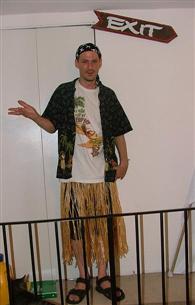
|
|
Scott after a Jimmy Buffett concert
|
7) Apogee was an early pioneer in terms of teaming up with external designers and studios, and continues to do so even to this day (currently working with Human Head Studios on Prey). Why is it that so few other studios do this (mentor and fund outside projects with lesser known teams)?
I think today at least they do not want to take the chance because its so easy these days to make something that looks good but is no fun. It seems in the past, alot of publishers where putting out anything that "looked good" but didn't sell.
8) What the biggest difference in the industry nowadays versus when you worked with Apogee?
Shareware was new so it was easier to make something small that had a big impact.
9) What have you been doing since your time with Apogee?
I moved back to Chicago ( where Im from ) and renamed my Company to "Mountain King Studios". To this day, I am still making shareware games and now selling them too. My Girlfriend Nadeya moved in with me and we play "Worlds Of Warcraft" together alot. For the last 2 years I have been working on not a game, but a "paint/animation" program which will hopefully be done soon.
10) If you're no longer making games, have you thought about returning to this industry? If not, why not?
N/A
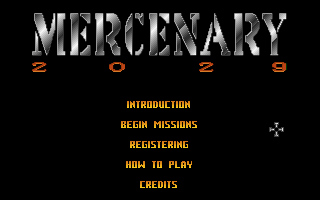
|
|
Title screen for Raptor when it was known as "Mercenary 2029"
|
11) Looking back, are there any missed opportunities that you wish you'd have jumped on?
Not really. I wish I didn't try making an RPG 3 times in the last ten years. I put alot of time in trying to make the games yet they never got done, but it was fun trying.
12) Other than your game(s), what's your favorite game released or produced by Apogee (or 3D Realms)?
Duke Nukem 3D and Wolfenstein.
12a) And what's your favorite 2-4 games released by anyone else?
I like so many games, I will just name the ones I put the most time in playing... Origins Ultimas ( all ) WarCraft 2 StarCraft Elite Force
13) Is there anything else you'd like to add about your time here or to fans of your title(s)?
This ain't no dinosaur game!
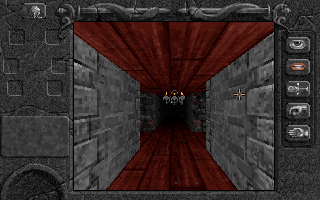
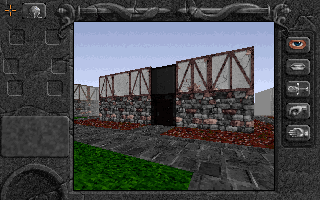
Screenshots from the abandoned Apogee RPG, "The Second Sword"
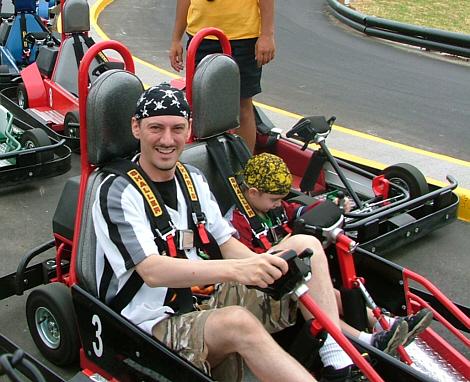
Scott with his son Dean at a Go Kart track
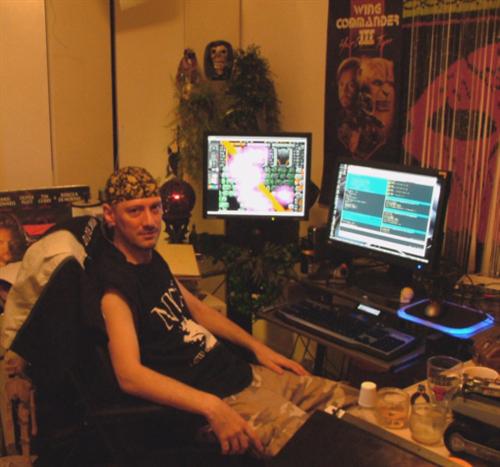
Scott at his computer at home.
Thanks again to Scott for helping out. Raptor had one unique thing in it's release date, it was put out on April 1st, 1994. At the time, most people didn't believe we were actually going to do that, they thought it was a joke. Since then, we've released a few other things on April 1st - each time most people don't believe it's actually happening. :)
Make sure and tune in again next Monday morning, when we bring you the next in our Legacy Interview series.
Posted by Joe Siegler at 12:00 PM
| Discuss this story on our forums
|
 |
 |
 |
 |
 |
Prey Weekly Development Update #13
Hello again -- welcome to the thirteenth installment of the Weekly Prey Update.
This week, we have the usual weekly status, an update on in-game dialog, some talk about the 360 version, and something a bit special: pictures of the Human Head visit to Art Bell's house to record his voice for the game.
We're in full-on crunch mode here at Human Head Studios. Many people are burning the midnight oil as they work to finish their tasks before our next major deadline.
I read the last few Weekly Updates, and it seems that my mantra lately has been "bug fixing and tweaking". Well, this week is no different -- there's been a ton of bug fixes and a lot of tweaks.
We're pretty much over the feature hump, as all of the major features we wanted are now implemented. From here to end, it will mainly be bug fixing, tweaking, and any remaining minor features as needed.
A few weeks ago I mentioned that Michael Greyeyes was here recording new lines for Tommy. This week most of those lines have been processed and are being added to the game. Probably half of the new lines are now in the game with the rest planned to be implemented next week.
Today we're recording a few new lines for the epilogue of the game -- and probably getting a few more screams out of the voice actors. Can never have enough screams in a game.
Of course, this time we'll inform our neighbors of the voice recording session so they don't call the cops.
Speaking of voice recording: Several months ago, Ed Lima (Audio Director at Human Head) and Tim Gerritsen (Business Development Manager at Human Head) flew out to Las Vegas to meet with Art Bell to record specific dialog for Prey.
For those of you who aren't familiar with Art Bell, he's the infamous host of "Coast to Coast". "Coast to Coast" is a radio show where people call in with tales of the fantastic -- they cover things ranging from Bigfoot to werewolves to alien invasions. The show is regularly hosted by George Noory, but Art Bell still occasionally hosts on weekends.
Now how does this fit in with Prey? Well, when designing the game we realized we needed some way for Tommy to connect with Earth even though he's trapped on an alien ship orbiting many miles above the planet. What better way to get information about Earth than to have Tommy come across places where the aliens are intercepting Earth's transmissions?
When we discussed this idea, someone mentioned how awesome it would be to have those transmissions actually be Art Bell broadcasts. We contacted Art's people and he thought the idea was great and agreed to provide his voice for Prey.
After a few months of playing phone tag to set things up, we finally nailed down a date to record the lines. Ed and Tim visited Art at his home -- where he actually broadcasts his show. Since Art already had high quality recording equipment set-up in his studio, they literally recorded the Prey lines by having Tim call into Art's studio from a separate phone.
Art was a total professional. Without even looking at the script in advance, he nailed the whole thing in almost literally one take. There were only two times that he stopped to re-record a few lines. The whole process took about 45 minutes.
In the end, the new lines turned out great -- they convey at some information of what is happening back on Earth. Some of them even manage to inject a bit of humor into the game.
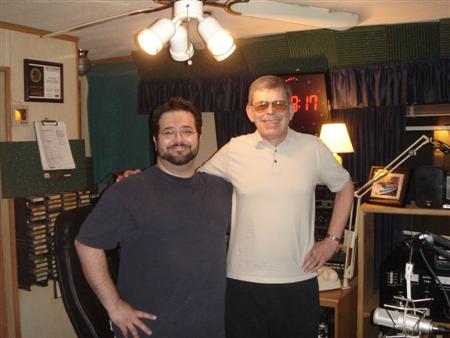 Art Bell and Ed Lima
Art Bell and Ed Lima

Art Bell and Tim Gerritsen
A number of people here (and at 3DR) have been testing the Xbox360 version of Prey -- we both have several test kits throughout the office, so people can play when they have time. Ted Halsted, lead level designer on Prey, has been going through the 360 version looking for any really slow areas. I watched him play through a particularly complex level, and the 360 appeared to be handling it just fine.
Time for the weekly changelog:
- Portaling is considerably smoother. It's pretty much impossible to detect when you go through a portal now.
- Fixed some bugs with the functionality to retain the ammo type in dropped leechguns in MP.
- Fixed Prey window sometimes getting resized when using the menu options to go to driver pages and possibly other things.
- Now checking Creative driver version, and disabling on old versions so that we don't cause bluescreens.
- Tracked down and fixed a crash bug in AI navigation
- Cleaned up some client prediction misses with the acid sprayer.
- Globalizing remainder of Tommy's v/o.
- Extracting additional Tommy pickup v/o
- Selecting more licensed music to round out in-game jukebox song selection
- Writing/prepping epilogue dialog for recording
- auto detection revamp texture quality setting and removed global video quality setting.
- Changed proxdoors so they no longer snap shut when a monster dies inside one.
- Fixed IK while crouching in players in multiplayer.
- Some save / load fixes.
- Added code to prevent Harvesters from getting stuck in passageways.
- Fixed a rare crash bug related to reactions that would show up on save.
- Fixed Gasbag death time.
- made shuttles show crosshair even when no tractor target.
- plaque under "Game Saved." messages
- made normal projectiles hit spirit secrets
- made spirit arrows pass through chaff
- Misc art tweaks
- Finalizing cinematic animation cleanup
- Fixed a bug with the Spiritwalk overlay not working well with other overlays
- Bug fix so Talon properly lands on moving targets
- System in place for Tommy making comments to Talon
- Removed redundant ammo types from the levels
Well, that's it for this week --
We decided to extend the Ask Prey submission time by another week. The original deadline was today, but if you still have any questions or anything you'd like to see covered in these weekly updates, feel free to email them to [email protected].
Until next time, stay out of trouble.
Chris Rhinehart - Prey Project Lead
Human Head Studios

Click the screenshot to watch Prey in action on the videos page!


Additionally, if you are a gaming news website, and wish to be updated directly with notification of these updates, please email us with a link to your website and a request to be added, and we'll email you with the next update.
Posted by Joe Siegler at 3:31 PM
| Discuss this story on our forums
|
 |
 |
 |
 |
 |
The Apogee Legacy #13 - Andy Edwardson
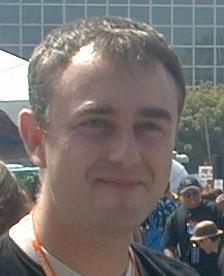 Today our "Apogee Legacy" Interview series continues on with an interview with Andy Edwardson. Andy did one title with us, a racing game back in 1994, called "Wacky Wheels". This game continues to have quite a following to this day, and was one that has been remembered quite fondly. Today our "Apogee Legacy" Interview series continues on with an interview with Andy Edwardson. Andy did one title with us, a racing game back in 1994, called "Wacky Wheels". This game continues to have quite a following to this day, and was one that has been remembered quite fondly.
Andy was one of our overseas developers, he's from the UK, and back in 1994, it meant getting builds was a little more adventersome (and slow) than it is today in the land of the Internet and broadband connections. Wacky Wheels was also one of the first games to include a "Dopefish Cameo", something that has become somewhat accepted when a game is made by someone who was involved from back in the the day. :)
Andy is no longer in the game industry, but once he was tracked down, he was quite happy to contribute to our series.
1) How did you first come in contact with Apogee?
It is a bit hazy but I guess it was about 1992/93. Scott Miller contacted my partner Shaun Gadalla, who did the graphics for Wacky Wheels , and expressed an interest in taking the game on.
2) Was there a reason you decided to work with Apogee, say versus going on your own or working with another company?
In our opinion Apogee was the top shareware company and the commerical outfits did not think that arcade games on the PC had any future. Wolf really showed that anything was possible. Plus Scott is a great sales guy as well ;)
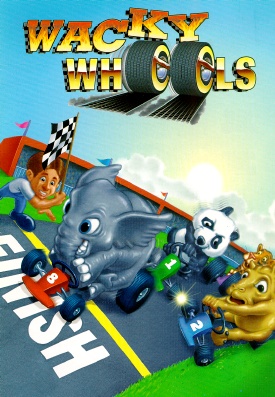
|
|
Wacky Wheels Manual Artwork
|
3) Looking back, was there anything Apogee could have done better, regarding the marketing and distribution of your game?
Well I doubt it had anything to do with Apogee but the really annoying thing for me was that I wanted to see our game in regular stores. I used to get really mad when I saw other titles in the shops but never ours. Apparently Formgen had plans to make it retail but it never seemed to happen.
4) Do you think your game was made better or worse by working with Apogee?
Better.
5) Apogee had a policy of letting the designer or studio retain full intellectual property rights to their game. Nowadays, it's rare to find a publisher who allows this, especially if the publisher is providing the funding. Do you believe that it's best for the creator to retain IP rights? Why or why not?
Not sure if IP meant much back then to us. My gut feeling though is that the creator should retain the rights to the IP but then again I find it hard not to be on the fence on this subject. Surely it all depends how much the publisher has invested in it as well.
5a) And if applicable, have you benefited from retaining ownership of your own IP?
I guess we own the IP but I cannot think of any real benefit.
5b) Do you think there'll ever be a sequel to your game(s)?
I doubt it. There has been a few times I thought about it but not as much these days.
6) Is there any story/incident that stands out as interesting during your time associated with Apogee?
Seeing a framed cover of our game in your offices in Garland next to all the classics you had brought out. That was a cool moment. Oh and going to George's house and meeting his Shark. Originally the Shark in Wacky Wheels was called "Bubbles". George told me that it was a bit of a sissy name for a Shark. I renamed him to Razer because of that.
7) Apogee was an early pioneer in terms of teaming up with external designers and studios, and continues to do so even to this day (currently working with Human Head Studios on Prey). Why is it that so few other studios do this (mentor and fund outside projects with lesser known teams)?
My perception has always been that Apogee/3d Realms are a kind of mini publisher/developer hybrid. I am not so sure that other studios would feel as comfortable doing this. Like you say, you have been doing this forever, and it works for you.
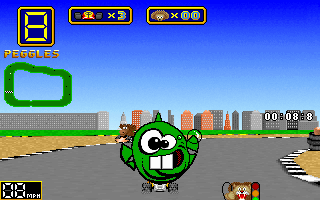
|
|
Wacky Wheels Screenshot with Dopefish Cameo
|
8) What the biggest difference in the industry nowadays versus when you worked with Apogee?
The sense of adventure back then was really great. It was a magic time. The industry seems much more formulaic today and kind of sterile in a lot of ways.
9) What have you been doing since your time with Apogee?
Well it's been over ten years now and a lot of stuff has happened. As far as my professional life goes I have been writig lots of software and hoping for that magic to return again :)
10) If you're no longer making games, have you thought about returning to this industry? If not, why not?
I do not make games anymore but I design and architect software for education. I find that my old games experience comes in handy. As far as returning to the industry , I doubt anybody would have me!!!
11) Looking back, are there any missed opportunities that you wish you'd have jumped on?
I wish we had joined Apogee earlier on. A little known fact is that we had a game cancelled by Apogee. It does not appear in the FAQ but it was called Prime Time Warrior. Anyway shortly aftert that we where asked to come over and work for you guys. I kind of regret not doing that.
12) Other than your game(s), what's your favorite game released or produced by Apogee (or 3D Realms)?
Monster Bash. I loved that game to bits.
12a) And what's your favorite 2-4 games released by anyone else?
Doom & Pac-Man.
13) Is there anything else you'd like to add about your time here or to fans of your title(s)?
Remember Kids Wacky Wheels is only a simulation. Don't drive like that in real life.
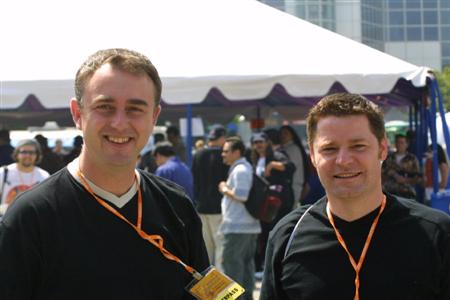
The Wacky Wheels Team at E3 2001.
Andy Edwardson & Shaun Gadalla
Thanks again to Andy for agreeing to contribute. Wacky Wheels was one of the more fun games in development for me personally in my time here at Apogee. There is more to the Wacky Wheels Story as well. A few years back Andy wrote some text about Wacky Wheels' development for the Apogee FAQ. I'm going to include that text here as well, but before you read that, check out these Wacky Wheels links:
Andy Edwardson's History of Wacky Wheels (as it appears in the Apogee FAQ):
Back in 1993, we were doing some low budget stuff for a Belgium outfit called Copysoft. I got fed up with the meager work, so I decided to work on a game engine in my spare time. I figured that the PC could do the mode7 stuff that the Super Nintendo was doing. I could not find any references for it, so I just studied Mario Kart and tried to figure out how it worked. I had a prototype engine up in about a week that did the floor painting and the rotation stuff. After that, I worked on it for a few more months, and Shaun Gadalla did artwork for it, and it started to get pretty solid. I showed it to the Copysoft crew, and they were quite excited and put a few screenshots of it on Compuserve. The problem was, we hadn't come to any commercial agreement with the company, and it was not a sure thing that they would get the game. Scott Miller, Apogee's president, happened to come across the screenshots and contacted Copysoft, and then we got into a fight with Copysoft over royalties, should Apogee end up distributing the game. I had made an unfortunate mistake -- I had included the C++ source code on the demo disk we left with them.
Shaun contacted Scott, and we came to an agreement. Shaun and I agreed to pay back what CopySoft had given us for equipment and so forth.
Development went on. When we went into beta we thought we would be out of there in a few weeks. However, when we got in there it was apparent that we needed more features. Beta was really important for me. If I had not listened to those testers, the game would not have been what it is. Most of the ideas came from us, but they kept the pressure up. It would have been too easy to sit on our hands and think what we were doing was best. The testers kept me on my toes, and, best of all, they told the truth. Another thing was Joe Siegler. I hate to admit this, but I didn't understand why he was so blunt all the time. I was so wrapped up in myself and becoming a bit of a pre-madonna. It was only later that I realized Joe was just being honest with us and trying to help us make the best game possible. I think Joe symbolizes what Apogee is; he works so hard all the time, and he practically lives there. At any rate, at one point I wanted to make amends with him. I knew he was into Dopefish, so I asked if we could put the fish in as a cameo. We discussed how it might work, and he sent me some stills and a collection of belches that he had recorded when he sat down one night with a microphone and a two liter bottle of Diet Coke. I picked one of them, but I think that Joe would have preferred it if I had picked one of the louder ones he sent me!
Because Doom had introduced the concept of modem play, the beta testers wanted it. Despite popular belief, Rise of the Triad did not introduce Remote Ridicule -- Wacky Wheels had it first. Rise of the Triad did take it one step further by allowing you to type messages to each other. At any rate, modem play really made my head spin. I never realised how unreliable packets were until I did the multiplayer engine. My hat goes off to John Carmack for his net play engine. To make matters worse, I was working at Shaun's place, and his phone lines were awful. But it did make the protocol really robust!
The music in Wacky Wheels was really lacking, and George Broussard said we needed more tunes. Jim Dose had just been hired at Apogee, and he had a terrific sound engine. We ripped out the old one and put his in. Jim also put us in touch with Mark Klem, and I would spend hours on the phone with him listening to his music. I really love the stuff he did, and I really should contact him for old time's sake.
As testing went on, I got more and more worried that, in the wake of Doom, all gameplayers wanted now was blood and guts, and Wacky Wheels wasn't about that. But we kept going, and I was determined to make it work. Anything the beta testers wanted, they got, except for the rear view mirror suggestion they kept plugging for. I didn't think it lent anything to the game, and it would have meant rendering another 3D view in another little window.
One memorable moment for us was when Shaun and I flew over to Texas, and we went to see George and Scott at the Apogee offices. I will never forget going into and seeing the pictures on the wall. They had the cover art for each of their games in a frame. Wacky Wheels was next to Wolfenstein 3D. That was an incredible moment in my life -- to be anywhere near associated with one of the greatest games of all time was neat to say the least. We went out to dinner with George and Scott, then visited their houses. (George had this bloody great big shark in a tank!) We got to talking about games, and George showed us Pitfall and asked if we could do anything like that. After Wacky Wheels, we did a test engine for them, but they were moving into the 3D market by then, and we didn't have anything to offer in that area at the time.
Anyway, we finally cracked the modem play, and it had one final round in beta testing. Joe Siegler gave it a good test, and he was happy with it. So it was finally ready to ship.
Then the bombshell hit us. Scott faxed us that Skunny Kart, a game from Copysoft that used my engine, had hit Compuserve. My heart sank. The only saving grace was that it was not all that similar to Wacky Wheels, and there was quite a legal wrangle over it all.
I was so angry, and it took all of Shaun's resolve to stop me from acting rashly. There was no way Copysoft had the ability to write an engine like that from scratch. In a perverse way, it taught me a valuable lesson. I was very hurt by it all, and it still bothers me to this day. In hindsight we were very stupid and should have known better.
If I could turn the clock back and make Wacky Wheels violent, full of blood and gore would I? Nah. It was fun, and kids big and small can enjoy it.
Make sure and tune in again next Monday morning, when we bring you the next in our Legacy Interview series.
Posted by Joe Siegler at 3:38 PM
| Discuss this story on our forums
|
 |
 |
 |
 |
|

 |
